中西方建筑文化差异 中英文版
- 格式:ppt
- 大小:5.21 MB
- 文档页数:25
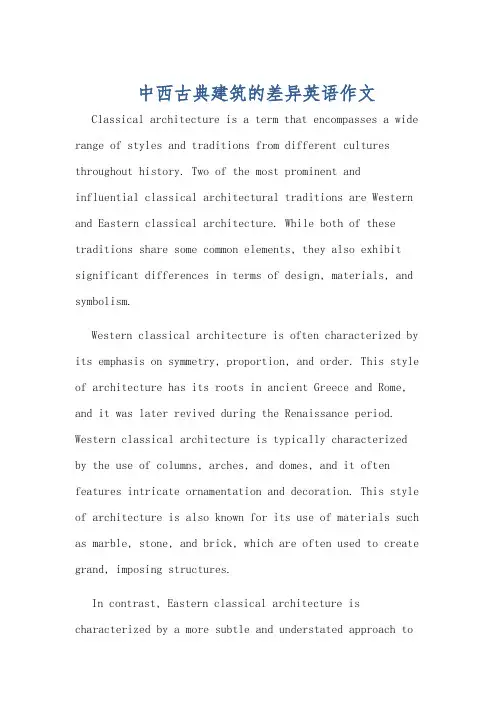
中西古典建筑的差异英语作文Classical architecture is a term that encompasses a wide range of styles and traditions from different cultures throughout history. Two of the most prominent andinfluential classical architectural traditions are Western and Eastern classical architecture. While both of these traditions share some common elements, they also exhibit significant differences in terms of design, materials, and symbolism.Western classical architecture is often characterized by its emphasis on symmetry, proportion, and order. This style of architecture has its roots in ancient Greece and Rome, and it was later revived during the Renaissance period. Western classical architecture is typically characterized by the use of columns, arches, and domes, and it often features intricate ornamentation and decoration. This style of architecture is also known for its use of materials such as marble, stone, and brick, which are often used to create grand, imposing structures.In contrast, Eastern classical architecture is characterized by a more subtle and understated approach todesign. This style of architecture is prevalent in East Asia, particularly in China and Japan, and it is often associated with the principles of feng shui. Eastern classical architecture typically emphasizes balance, harmony, and simplicity, and it often features natural materials such as wood, bamboo, and stone. This style of architecture is also known for its use of gardens and water features, which are often incorporated into the design of buildings to create a sense of tranquility and serenity.One of the most significant differences between Western and Eastern classical architecture is their approach to symbolism. In Western classical architecture, symbolism is often used to convey political, religious, or cultural messages. For example, the use of columns in ancient Greek and Roman architecture was often meant to symbolize strength and stability, while the use of arches and domes in Gothic architecture was meant to evoke a sense of awe and reverence.In contrast, Eastern classical architecture tends to be more subtle and nuanced in its use of symbolism. In Chinese architecture, for example, the use of certain materialssuch as jade, bronze, and gold was often meant to symbolize wealth, power, and good fortune. Similarly, the use of certain colors, such as red and gold, was meant to convey happiness, prosperity, and good luck.Another significant difference between Western and Eastern classical architecture is their approach to space. In Western classical architecture, space is often used to create a sense of grandeur and monumentality. Buildings are often designed to be imposing and impressive, with large, open spaces that are meant to evoke a sense of awe and reverence.In contrast, Eastern classical architecture tends to be more focused on creating a sense of intimacy and tranquility. Buildings are often designed to be smaller and more intimate, with a greater emphasis on the use of natural materials and the incorporation of gardens and water features. This creates a sense of harmony and balance that is meant to promote relaxation and contemplation.In conclusion, while Western and Eastern classical architecture share some common elements, they also exhibit significant differences in terms of design, materials, andsymbolism. Western classical architecture is often characterized by its grandeur, ornamentation, and use of materials such as marble and stone, while Eastern classical architecture tends to be more understated and focused on creating a sense of harmony and balance through the use of natural materials such as wood and bamboo. Understanding these differences is essential for appreciating the rich and diverse traditions of classical architecture from around the world.。
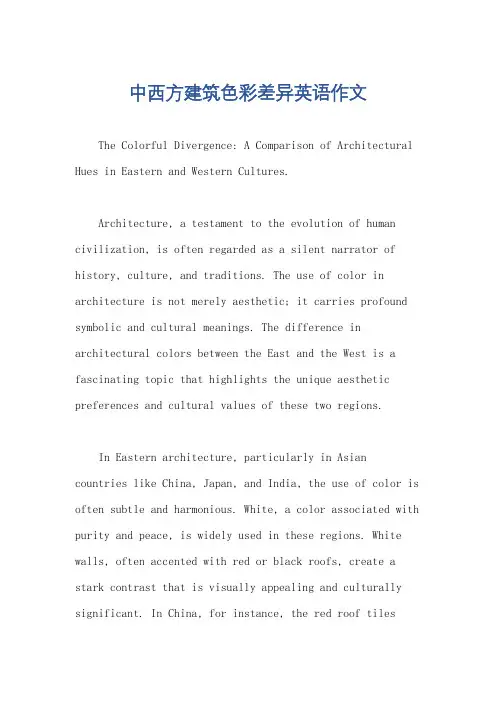
中西方建筑色彩差异英语作文The Colorful Divergence: A Comparison of Architectural Hues in Eastern and Western Cultures.Architecture, a testament to the evolution of human civilization, is often regarded as a silent narrator of history, culture, and traditions. The use of color in architecture is not merely aesthetic; it carries profound symbolic and cultural meanings. The difference in architectural colors between the East and the West is a fascinating topic that highlights the unique aesthetic preferences and cultural values of these two regions.In Eastern architecture, particularly in Asian countries like China, Japan, and India, the use of color is often subtle and harmonious. White, a color associated with purity and peace, is widely used in these regions. White walls, often accented with red or black roofs, create a stark contrast that is visually appealing and culturally significant. In China, for instance, the red roof tilessymbolize prosperity and good fortune, while white walls reflect the values of simplicity and modesty. This color scheme is also prevalent in Japanese architecture, where white walls and black or gray tiled roofs blend harmoniously with the natural environment.On the other hand, Western architecture tends to be more bold and vibrant in its color choices. In European countries, the use of various hues and shades is common, reflecting the region's rich history and diverse cultural influences. Red, for instance, is a popular color in many European countries, associated with passion, power, and royalty. The red facades of palaces and castles in France, England, and Spain reflect this association. Yellow, another prominent color in Western architecture, is often seen in Gothic cathedrals, symbolizing divinity and holiness.The difference in color preferences can be traced back to the historical, geographical, and religious backgrounds of these regions. Eastern cultures, influenced by Confucianism, Taoism, and Buddhism, emphasize harmony withnature and a balanced, inward-looking lifestyle. This philosophy is reflected in the use of natural colors like white, black, and brown, which blend seamlessly with the natural environment. By contrast, Western cultures, shaped by Greco-Roman traditions, the Renaissance, and the Industrial Revolution, tend to be more outgoing and expressive. This is reflected in the use of vibrant colors that stand out and make a statement.Moreover, the materials used in construction also play a role in determining the color palette of architecture. In the East, natural materials like wood, stone, andterracotta are commonly used, resulting in a more earthy and organic color scheme. In the West, brick, stone, and concrete are frequently employed, allowing for a wider range of color expressions.In conclusion, the colorful divergence in architectural hues between the East and the West is a testament to the rich cultural and historical differences that exist between these regions. Eastern architecture, with its harmonious and natural color schemes, reflects the values ofsimplicity, modesty, and harmony with nature. By contrast, Western architecture, with its bold and vibrant hues, embodies the spirit of expression, diversity, and innovation. Both approaches have their unique charm and beauty, contributing to the rich and diverse architectural landscape of the world.。
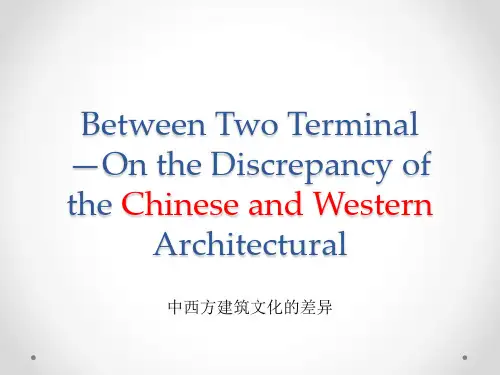

中西建筑之韵:异曲同工的艺术之美Western architecture, with its grandeur and elegance, stands as a testament to the aesthetic preferences and cultural values of the Occident. In contrast, Eastern architecture, particularly Chinese architecture, exudes a unique charm that is deeply rooted in its historical and cultural context. While the two share some fundamental principles of design and construction, they differ significantly in terms of their aesthetic approach, material usage, and spatial organization.Western architecture, especially in the classical era, is known for its symmetry, geometric perfection, and the use of durable materials like marble and granite. The Greek temples, Roman palaces, and Gothic cathedrals are allexamples of Western architecture that emphasize verticality, light, and space. These buildings are designed to evoke a sense of awe and grandeur, reflecting the Western ideal of order and harmony with nature.In contrast, Chinese architecture emphasizes horizontal lines, symmetry, and balance with its surrounding environment. The use of wood, brick, and tile as primarymaterials gives Chinese buildings a unique warmth and texture that is lacking in Western structures. Chinese temples, palaces, and gardens are designed to blend harmoniously with their natural surroundings, reflecting the Chinese philosophy of harmony with nature and the universe.Another significant difference lies in the spatial organization of the two styles. Western buildings are often designed with a clear hierarchy of spaces, with the main entrance, hall, and chapel or altar arranged in a linear fashion. This organizational principle reflects the Western ideal of hierarchy and order. In contrast, Chinesebuildings often feature a more open and fluid spatial layout, with courtyards, pavilions, and gardens arranged in a more organic and free-flowing manner. This layout allows for a more interactive and dynamic experience of the space, reflecting the Chinese emphasis on harmony and flow.Despite these differences, however, there are also many similarities between Western and Chinese architecture. Both styles seek to create a sense of balance and harmony within their designs, and both make use of architecture as amedium to express cultural values and ideological beliefs. Furthermore, both Western and Chinese architects have always been innovative and experimental in their approaches to design, constantly pushing the boundaries of what is possible in terms of material usage, spatial organization, and aesthetic expression.In conclusion, while Western and Chinese architecture differ significantly in terms of their aesthetic approach, material usage, and spatial organization, they share a common goal of creating beautiful and harmonious spacesthat reflect the cultural values and beliefs of their respective societies. The diversity and richness of these two styles not only enrich our understanding ofarchitecture as an art form but also serve as a powerful reminder of the infinite possibilities and beauty that can be achieved when human creativity and ingenuity are harnessed for the betterment of society.**中西建筑之韵:异曲同工的艺术之美**西方建筑以其宏伟与优雅著称,体现了西方社会的美学偏好和文化价值观。
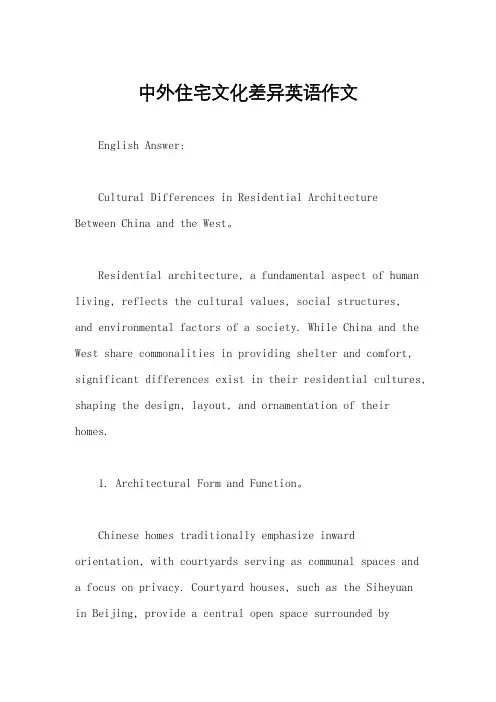
中外住宅文化差异英语作文English Answer:Cultural Differences in Residential Architecture Between China and the West。
Residential architecture, a fundamental aspect of human living, reflects the cultural values, social structures,and environmental factors of a society. While China and the West share commonalities in providing shelter and comfort, significant differences exist in their residential cultures, shaping the design, layout, and ornamentation of their homes.1. Architectural Form and Function。
Chinese homes traditionally emphasize inward orientation, with courtyards serving as communal spaces and a focus on privacy. Courtyard houses, such as the Siheyuanin Beijing, provide a central open space surrounded bybuildings on all sides. This design fosters family cohesion and offers protection from external influences. In contrast, Western homes often prioritize outward orientation, with open-plan layouts, large windows, and expansive views. They emphasize individual space and interaction with the surrounding environment.2. Space Planning。
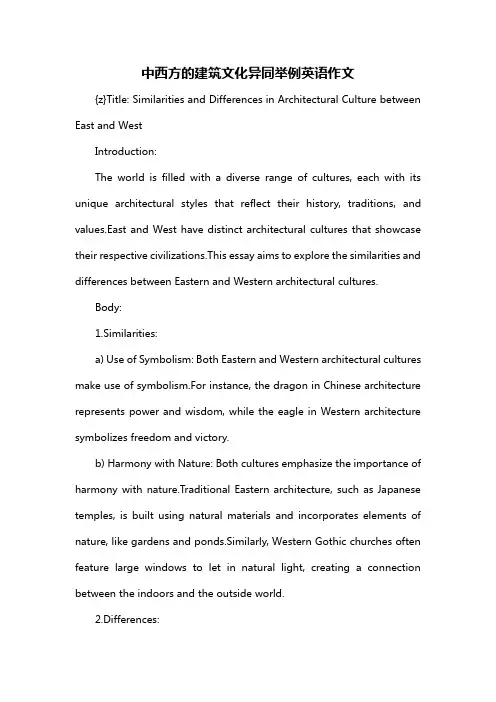
中西方的建筑文化异同举例英语作文{z}Title: Similarities and Differences in Architectural Culture between East and WestIntroduction:The world is filled with a diverse range of cultures, each with its unique architectural styles that reflect their history, traditions, and values.East and West have distinct architectural cultures that showcase their respective civilizations.This essay aims to explore the similarities and differences between Eastern and Western architectural cultures.Body:1.Similarities:a) Use of Symbolism: Both Eastern and Western architectural cultures make use of symbolism.For instance, the dragon in Chinese architecture represents power and wisdom, while the eagle in Western architecture symbolizes freedom and victory.b) Harmony with Nature: Both cultures emphasize the importance of harmony with nature.Traditional Eastern architecture, such as Japanese temples, is built using natural materials and incorporates elements of nature, like gardens and ponds.Similarly, Western Gothic churches often feature large windows to let in natural light, creating a connection between the indoors and the outside world.2.Differences:a) Style and Aesthetics: Eastern architecture is characterized by its use of intricate details, vibrant colors, and ornate decorations.The pagodas and temples in countries like Japan and China are excellent examples of this.In contrast, Western architecture tends to be more minimalistic, with an emphasis on proportion and symmetry.Buildings like the Parthenon in Greece represent this aesthetic.b) Structural Techniques: Eastern and Western architectural cultures differ in their structural techniques.Eastern architecture, particularly in countries like Japan, often uses wooden structures and sliding doors, which allow for flexibility and adaptability.Western architecture, especially during the Gothic period, utilized pointed arches and ribbed vaults to create large, open spaces.c) Functionality vs.Aesthetics: In Eastern architecture, functionality and practicality are often prioritized over aesthetics.Traditional Eastern homes, for example, are designed to maximize space and natural light.In contrast, Western architecture has a long history of prioritizing aesthetics, with buildings like the Colosseum in Rome being examples of grandeur and decoration.Conclusion:In conclusion, Eastern and Western architectural cultures have both similarities and differences.They both use symbolism and emphasize harmony with nature.However, they differ in terms of style, structuraltechniques, and the balance between functionality and aesthetics.Understanding these differences can help us appreciate the diverse range of architectural styles that exist in the world and learn from each other"s traditions.。
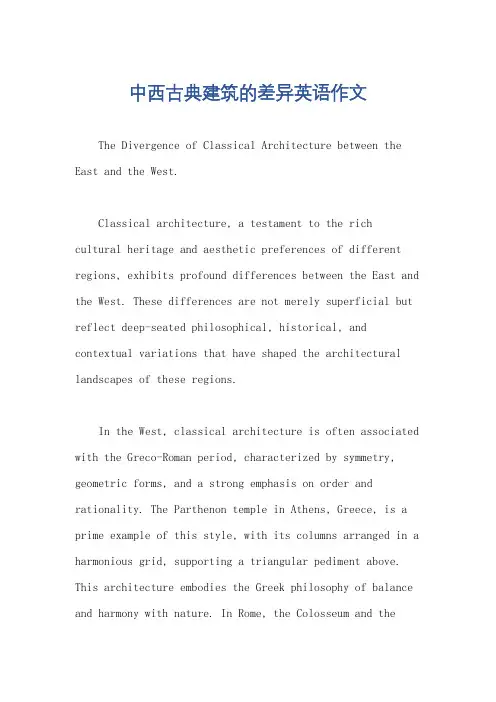
中西古典建筑的差异英语作文The Divergence of Classical Architecture between the East and the West.Classical architecture, a testament to the richcultural heritage and aesthetic preferences of different regions, exhibits profound differences between the East and the West. These differences are not merely superficial but reflect deep-seated philosophical, historical, and contextual variations that have shaped the architectural landscapes of these regions.In the West, classical architecture is often associated with the Greco-Roman period, characterized by symmetry, geometric forms, and a strong emphasis on order and rationality. The Parthenon temple in Athens, Greece, is a prime example of this style, with its columns arranged in a harmonious grid, supporting a triangular pediment above. This architecture embodies the Greek philosophy of balance and harmony with nature. In Rome, the Colosseum and thePantheon further emphasize the use of arches, domes, and vaults, creating a sense of grandeur and permanence.The Western classical tradition also extends to the Gothic period, which saw the emergence of pointed arches, flying buttresses, and stained glass windows. This style, found in cathedrals like Notre-Dame in Paris, France, is known for its soaring heights, intricate details, and a sense of otherworldliness. The Gothic architecture reflects a shift towards a more religious and spiritual aesthetic, with its emphasis on light and verticality.In contrast, Eastern classical architecture,particularly in China, Japan, and India, exhibits adistinct aesthetic. Chinese architecture, for instance, is characterized by its use of wood, tile roofs, and a harmonious blend with nature. The Forbidden City in Beijing, China, is a testament to this style, with its intricate wooden carvings, tiled roofs, and庭院(courtyards) that provide a sense of serenity and tranquility. This architecture reflects the Chinese philosophy of harmonywith nature and the universe, emphasizing flow and balance.Japanese architecture, on the other hand, is known for its use of wood, paper, and shingle roofs. The traditional Japanese house, or "Washikura," features sliding paper screens that provide privacy and flexibility in space. This architecture, influenced by Zen Buddhism, emphasizes simplicity, tranquility, and a connection with nature. The same can be said for the temples and pagodas of Japan, which often blend harmoniously into the landscape.Indian architecture, too, has a rich and diverse history. The Taj Mahal in Agra, India, is a masterpiece of Mughal architecture, combining Islamic and Indian styles. Its white marble exterior and intricate carvings reflect a blend of geometry and natural forms, embodying the Indian aesthetic of rasa (sentiment) and raga (melody).The differences in classical architecture between the East and the West can be attributed to various factors. Geographically, the availability of materials and the need to adapt to different climatic conditions have played a crucial role. Culturally, the influence of differentreligions, philosophies, and artistic traditions has shaped the aesthetic preferences of each region. Historically, the political and social landscapes have also impacted the development and evolution of classical architecture.In conclusion, the differences in classicalarchitecture between the East and the West are not just about style or aesthetic preferences but reflect deeper cultural, historical, and philosophical differences. These differences have given rise to unique and diverse architectural landscapes that continue to inspire and influence architects and designers worldwide.。
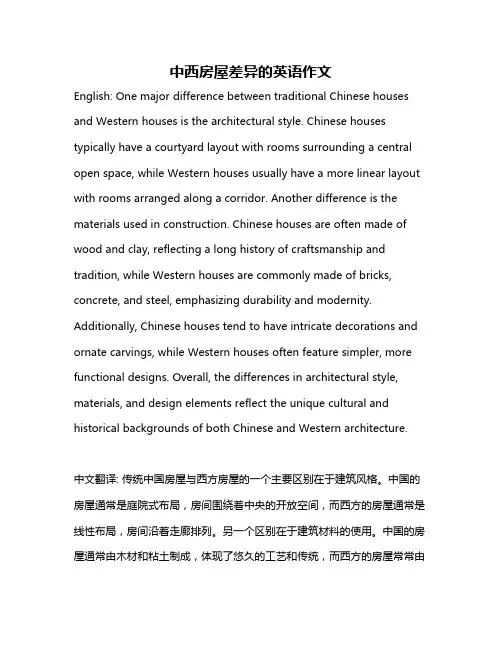
中西房屋差异的英语作文English: One major difference between traditional Chinese houses and Western houses is the architectural style. Chinese houses typically have a courtyard layout with rooms surrounding a central open space, while Western houses usually have a more linear layout with rooms arranged along a corridor. Another difference is the materials used in construction. Chinese houses are often made of wood and clay, reflecting a long history of craftsmanship and tradition, while Western houses are commonly made of bricks, concrete, and steel, emphasizing durability and modernity. Additionally, Chinese houses tend to have intricate decorations and ornate carvings, while Western houses often feature simpler, more functional designs. Overall, the differences in architectural style, materials, and design elements reflect the unique cultural and historical backgrounds of both Chinese and Western architecture.中文翻译: 传统中国房屋与西方房屋的一个主要区别在于建筑风格。
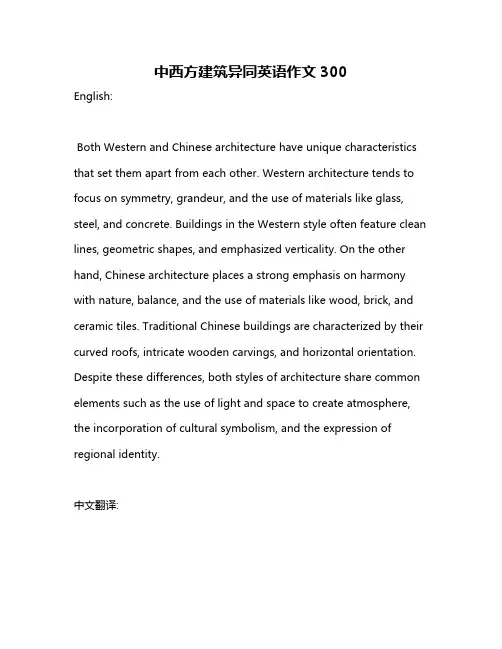
中西方建筑异同英语作文300English:Both Western and Chinese architecture have unique characteristics that set them apart from each other. Western architecture tends to focus on symmetry, grandeur, and the use of materials like glass, steel, and concrete. Buildings in the Western style often feature clean lines, geometric shapes, and emphasized verticality. On the other hand, Chinese architecture places a strong emphasis on harmony with nature, balance, and the use of materials like wood, brick, and ceramic tiles. Traditional Chinese buildings are characterized by their curved roofs, intricate wooden carvings, and horizontal orientation. Despite these differences, both styles of architecture share common elements such as the use of light and space to create atmosphere, the incorporation of cultural symbolism, and the expression of regional identity.中文翻译:西方和中国的建筑都有独特的特点使它们彼此区分开来。
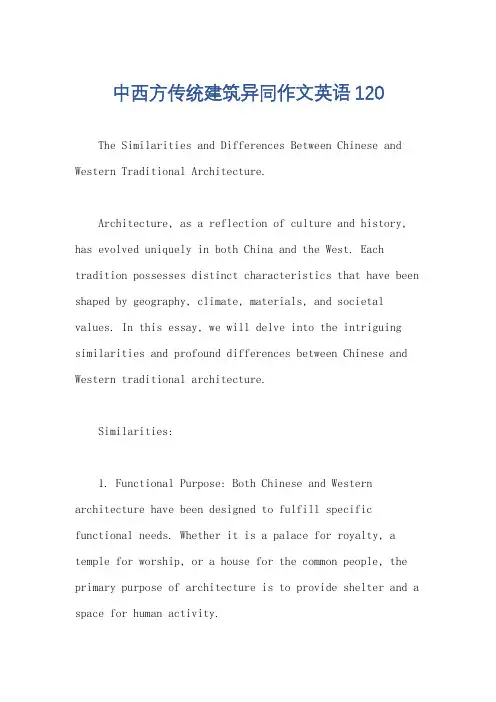
中西方传统建筑异同作文英语120The Similarities and Differences Between Chinese and Western Traditional Architecture.Architecture, as a reflection of culture and history, has evolved uniquely in both China and the West. Each tradition possesses distinct characteristics that have been shaped by geography, climate, materials, and societal values. In this essay, we will delve into the intriguing similarities and profound differences between Chinese and Western traditional architecture.Similarities:1. Functional Purpose: Both Chinese and Western architecture have been designed to fulfill specific functional needs. Whether it is a palace for royalty, a temple for worship, or a house for the common people, the primary purpose of architecture is to provide shelter and a space for human activity.2. Symbolic Representation: Both traditions employ architecture as a means of symbolic representation. In China, the Forbidden City represents the absolute power of the emperor, while in the West, cathedrals symbolize the grandeur of God and the church.3. Aesthetic Appeal: Both Chinese and Western architecture aim for aesthetic appeal. The intricate carvings, elaborate designs, and harmonious proportions found in both traditions demonstrate a shared pursuit of beauty.4. Use of Natural.。
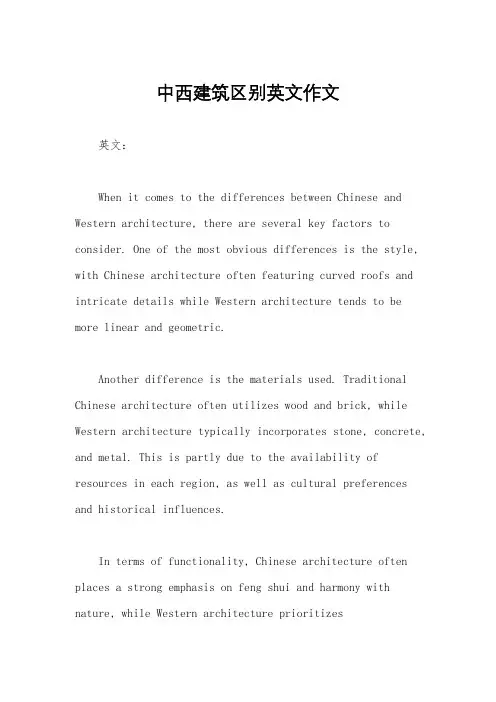
中西建筑区别英文作文英文:When it comes to the differences between Chinese and Western architecture, there are several key factors to consider. One of the most obvious differences is the style, with Chinese architecture often featuring curved roofs and intricate details while Western architecture tends to be more linear and geometric.Another difference is the materials used. Traditional Chinese architecture often utilizes wood and brick, while Western architecture typically incorporates stone, concrete, and metal. This is partly due to the availability of resources in each region, as well as cultural preferences and historical influences.In terms of functionality, Chinese architecture often places a strong emphasis on feng shui and harmony with nature, while Western architecture prioritizesfunctionality and efficiency. This can be seen in the layout of buildings and the use of space, as well as the incorporation of technology and modern amenities.Overall, both Chinese and Western architecture have their own unique strengths and characteristics. While Chinese architecture may be more ornate and symbolic, Western architecture tends to prioritize practicality and innovation.中文:中西方建筑的区别有很多方面需要考虑。
中西方建筑异同英语作文Chinese and Western Architecture: A Comparative Study.Architecture, being a reflection of a culture's values, beliefs, and aesthetics, plays a pivotal role in defining the identity of a civilization. China and the West, with their distinct historical backgrounds and traditions, have developed unique architectural styles that have stood the test of time. This essay aims to delve into thesimilarities and differences between Chinese and Western architecture, exploring the factors that have influenced their evolution and the ways they have influenced the global architectural landscape.1. Materials and Techniques.Western architecture, especially in the Classical era, was predominantly made of stone, with techniques such as masonry and arches used extensively. This stone-based construction was durable and resistant to fire, making itsuitable for the construction of large, permanentstructures like temples, palaces, and forts. In contrast, Chinese architecture primarily relied on wood, a material that was plentiful in China's forested regions. Wood was easy to work with, allowing for intricate carvings and details. However, it was also susceptible to decay and fire, necessitating regular maintenance and repairs.2. Spatial Orientation.Western architecture often follows a symmetrical layout, with a clear hierarchy of spaces. The central axis isusually occupied by the most important space, such as the altar or the throne room, surrounded by smaller, secondary spaces. This organizational principle is reflected in many Western landmarks, such as the Parthenon in Greece or the Palace of Versailles in France. In contrast, Chinese architecture tends to be more flexible and organic in its spatial arrangement. Buildings often follow a free-form layout, with spaces flowing seamlessly into each other.This is particularly evident in Chinese temples and gardens, where the aim is to create a harmonious and natural-feelingenvironment.3. Decorative Elements.Western architecture is known for its elaborate decorative elements, often featuring intricate carvings, sculptures, and paintings. These decorative elements were not just aesthetic but also served to communicate religious or historical narratives. In contrast, Chinese architecture tends to be more subtle in its decoration, relying instead on the natural beauty of materials and spatial arrangements. Chinese architects were masters of using landscaping, water features, and plantings to create a serene and harmonious environment.4. Philosophical Influences.Western architecture has been influenced by various philosophical movements, such as Platonic idealism, Renaissance humanism, and Modernism. These movements have shaped the way architects approach design, influencing the styles and forms of buildings. Chinese architecture, on theother hand, has been influenced by Confucianism, Taoism, and Buddhism. These philosophies emphasize harmony with nature, social order, and spirituality, which is reflected in the way Chinese buildings are designed and arranged.5. Global Influence.Both Chinese and Western architecture have had a profound influence on the global architectural landscape. Western styles, such as Gothic, Baroque, and Neoclassical, have been widely adopted and adapted by architects across the globe. Similarly, Chinese styles, such as the pagoda and the garden temple, have also influenced architects in other cultures. The influence of Chinese architecture can be seen in the design of buildings in Japan, Korea, and even in some parts of Europe and North America.In conclusion, Chinese and Western architecture, while distinct in many ways, share a common goal: to create spaces that are beautiful, functional, and meaningful. The differences between them can be traced back to their respective historical, cultural, and philosophicalbackgrounds. Understanding these differences not only helps us appreciate the uniqueness of each style but also allows us to gain insights into the values and beliefs of the cultures that gave birth to them.。